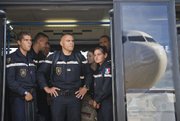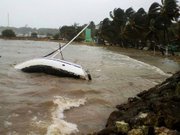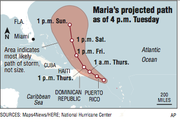SAN JUAN, Puerto Rico -- As rain began lashing Puerto Rico on Tuesday afternoon, the U.S territory's governor warned that Hurricane Maria could hit "with a force and violence that we haven't seen for several generations."
"We're going to lose a lot of infrastructure in Puerto Rico," Gov. Ricardo Rossello said, adding that a likely islandwide power failure and communication blackout could last for days. "We're going to have to rebuild."
Dominica's leader sent out an emotional plea for help as Maria smashed into that Caribbean island and caused "mind-boggling" devastation, but silence followed as the country lost all communications Tuesday.
Officials on the neighboring French island of Guadeloupe reported at least one death: a person hit by a falling tree. They said two other people were reported missing after their boat sank off La Desirade island, just east of Guadeloupe.
Click here for larger versions
Photos by The Associated Press
Photos by The Associated Press
Next in the storm's path was St. Croix in the U.S. Virgin Islands, where the storm was expected to hit late Tuesday. The island was largely spared the widespread damage caused by Hurricane Irma on the chain's St. Thomas and St. John islands just two weeks ago.
Almost two weeks after being grazed by Irma, residents of Puerto Rico were facing a direct hit from Maria, which could be the first Category 5 hurricane to strike the island in close to a century.
Just one Category 5 hurricane has hit Puerto Rico in recorded history, Hurricane Okeechobee, also known as San Felipe II, in 1928. Maria could become the second if it maintains its strength. The last Category 4 storm to strike the island occurred in 1932.
By Tuesday night, the National Hurricane Center in Miami said Maria's winds had intensified to 175 mph, and that some additional strengthening was possible. At 10 p.m., Maria was centered about 30 miles south-southeast of St. Croix, or 120 miles southeast of San Juan, Puerto Rico, and was moving west-northwest at 10 mph.
[HURRICANE TRACKER: Follow Maria’s projected path]
Maria's center was expected to pass several miles south of St. Croix late Tuesday on its way to Puerto Rico, prompting U.S. Virgin Islands Gov. Kenneth Mapp to ask that people remain alert.
Though St. Croix mostly escaped Irma's main wrath, this time the island was expected to experience five hours of hurricane-force winds starting about 11 p.m. local time, Mapp said.
"For folks in their homes, I really recommend that you not be in any kind of sleepwear," he said during a brief news conference late Tuesday. "Make sure you have your shoes on. Make sure you have a jacket around. Something for your head in case your roof should breach. ... I don't really recommend you be sleeping from 11 o'clock to 4 [a.m.]. ... Be aware of what's going on around you."
Hurricane center forecasters said it was likely that Maria would still be at Category 5 intensity when it moves over the U.S. Virgin Islands on Tuesday night and Puerto Rico today, carrying with it "life-threatening" flooding from rain and storm surge.
Forecasters said the storm surge could raise water levels by 6 to 9 feet near the storm's center. The storm was predicted to drop 10 to 15 inches of rain across the islands, with more in isolated areas.
"This is an unprecedented atmospheric system," Rossello said Tuesday. "It is time to act and look for a safe place if you live in flood-prone areas or in wooden or vulnerable structures."
'WE WILL NEED HELP'
Dominica Prime Minister Roosevelt Skerrit sent out a series of dramatic posts on his Facebook page as the storm blew over that tiny country late Monday -- but then stopped suddenly as phone and Internet connections with the country were cut.
In the last message before falling silent, he appealed for international aid: "We will need help, my friends, we will need help of all kinds."
The storm knocked out communications for the country, leaving anyone outside Dominica struggling to determine the extent of damage, though it was clearly widespread. "The situation is really grave," Dominica's consul general, Barbara Dailey, said in a telephone interview from New York.
She said she lost contact with the island around 4 a.m. At that point, officials had learned that 70 percent of homes had lost their roofs, including her own.
"I lost everything," she said, adding there had been no word on casualties. "As a Category 5 it would be naive not to expect any [injuries] but I don't know how many," she said.
The island's broadcast service also was down Tuesday and Akamai Technologies, a company that tracks the status of the Internet around the world, said most of Dominica's Internet service appeared to have been lost by midday. The Ross University School of Medicine in Dominica reported a widespread loss of communication on the island, and relatives of students posted messages on its Facebook page saying they had been unable to talk to their loved ones since late Monday evening as the storm approached.
Dominica is particularly vulnerable to flooding because of its steep mountains, cut through with rivers that rage even after a heavy rain. It was still recovering from Tropical Storm Erika, which killed 30 people and destroyed more than 370 homes in August 2015.
With Maria, the 2017 hurricane season has already featured four Category 4 or stronger storms; this has happened only four previous times by Sept. 18.
The hurricane season of 2017 is the first with two Category 5 storms since 2007.
Meanwhile Jose, which weakened to a tropical storm, is expected to behave like a strong nor'easter along the coast of the Northeast, from near Long Island off New York to eastern Massachusetts.
PUERTO RICANS WORRY
In the Puerto Rican capital, San Juan, normally crowded streets and beaches were empty by Tuesday afternoon as families heading to safe shelter packed up their cars and pets or secured windows and doors around their homes to prepare for severe winds expected to slam the island for 12 to 24 hours. Nearly 2,800 people were in shelters across Puerto Rico, along with 105 pets, officials said.
"We're definitely afraid," said Erica Huber, a 33-year-old teacher from Venice, Fla., who moved to Puerto Rico a month ago with her 12-year-old daughter.
"I'm more worried about the aftermath. Is there going to be enough food and water?" she said.
In shops across the island, shelves were bare after people filled shopping carts with the limited amount of water, batteries, baby formula, milk and other items they could find.
Puerto Rico was still healing the scars left behind by Hurricane Irma, which left three people dead and battered the island's troubled electrical system.
Officials said it was likely the electrical system would be knocked out again if Maria hits as expected.
Residents scrambled to buy generators and flocked to supermarkets and gas stations, expecting to be without power for weeks, maybe even months.
Roberto Rivera, 61, raced to buy canned foods and two 24-packs of water bottles.
"I came immediately because I couldn't buy anything for Irma," Rivera said inside a packed supermarket in San Juan. "I see everyone is on the same boat here."
Rivera is a construction worker for the government-owned Puerto Rico Electric Power Authority. Even he expects that the power grid will collapse.
"It's going to come down again," he said. "No doubt."
Burdened by the island's debt crisis, the utility essentially declared bankruptcy in July and cannot tap into capital markets after defaulting on $9 billion in bond debt.
Efforts to modernize the utility's plants, which burn imported oil to produce electricity, and to diversify energy sources have mostly come to a halt. Trees near power lines have gone untrimmed. Puerto Ricans have come to distrust the island's electrical grid, which started faltering hours before Irma grazed the island.
The situation is particularly dire in the U.S. Virgin Islands. Still reeling from the devastation left by Irma, the government there has urged residents not to take shelter in their devastated homes, instructing residents to take shelter in one of the territory's eight shelters.
Hurricane Irma knocked out the basic infrastructure in St. Thomas and St. John, leaving thousands of residents without homes, electricity, water, and telecommunications. St. Croix was virtually unscathed by Irma and has become the U.S. government's central command base for relief efforts in the region.
Hurricane Maria's eye is projected to pass over the southwest tip of St. Croix, Mapp, the Virgin Islands governor, said Tuesday.
"In effect, it will be a direct hit," he said.
Information for this article was contributed by Luis Ferre-Sadurni and Frances Robles of The New York Times; by Carlisle Jno Baptiste, Danica Coto, Ben Fox and Seth Borenstein of The Associated Press; and by Jason Samenow, Brian Murphy and Colis Ferguson of The Washington Post.
A Section on 09/20/2017


